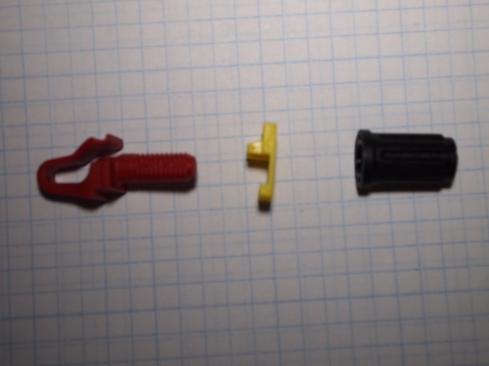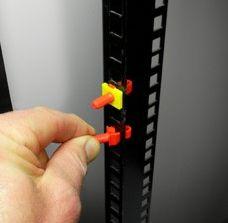The most innovative solution I've seen for connecting gear to the rack is the Rackstud, a glass- reinforced plastic product from New Zealand that also installs exclusively from the front of the rack. Unlike all the other products we've seen, Rackstuds attach the bolt, rather than the nut, to the rack.
Just as having threaded studs sticking out of a brake disk makes it easier to change a tire by holding up the wheel while you reach for the lug nuts, having Rackstuds sticking out makes it easier to mount gear on the rack since you don't have to support the full weight of the equipment while carefully keeping everything aligned and fumbling with the first screw.
As you can see from the photo below, each Rackstud has three parts. The red part snaps into the rack rail from the front and holds itself in place with spring action. The yellow part has a wedge that forces the red part's two sections apart, locking it into the rail and the black part is a knurled nut that holds the gear to the rack.
Figure 4:
The three parts of a Rackstud.
Figure 5:
Installing a Rackstud.
As much as I like the idea of Rackstuds -- I even bought a bag of 100 from Amazon -- I found them to be less than fully satisfying. While the square holes in rack rails are all supposed to be 3/8" (9.5mm), the tolerances are pretty generous. Some of my cabinets have smaller holes and it requires a significant amount of force to get a Rackstud into these. I've also discovered that the holes on the sides and back of the rails are just enough larger than the 3/8" standard, so that the Rackstuds fall through.
The manufacturers designed Rackstuds to support gear weighing up to 20KG (44lbs) and have tested the strength of the Rackstuds to insure a 3X safety factor. It seems to me that's strong enough to hold anything I'd think about hanging from rack ears, as opposed to using a rail or shelf of some sort -- assuming, of course, the Rackstuds fit securely in the rails to begin with. The manufacturer also warns against using them in racks that are shipped full of gear, like audio gear or trade show demo gear.
My invention: The RackHanger
When playing with the Rackstuds, I kept thinking that they were better suited to wiring closets, where all the gear hangs from ears, rather than server cabinets in the data center where rails are the default. However, most wiring closets I've worked in use 2-post racks with directly tapped holes. While this eliminates the need for cage nuts, it does leave techs juggling a switch, bolt and power screwdriver to get the first two screws in.
I'm wondering why someone doesn't take the concept of a hanger bolt, photo below, to create a stud hanger for two-rail racks. All it would take is a 2-inch bolt threaded in 10-32, 12-24 or one of the metric standards with a slightly enlarged hex section in the center. Tech could screw these hangers into the rail, the hex section would serve as a stop, and then hang the switch on the studs with knurled nuts or even wing nuts.

Well, dear reader, that really is all there is to know about mounting gear to your racks -- at least until someone sends me another alternative.
Don't miss Howard Marks at Interop New York, Sept. 30-Oct. 3. He'll present a workshop, "Making Cloud Storage Work For Your Organization," and a session, "Software-Defined Storage: Reality or BS?"











